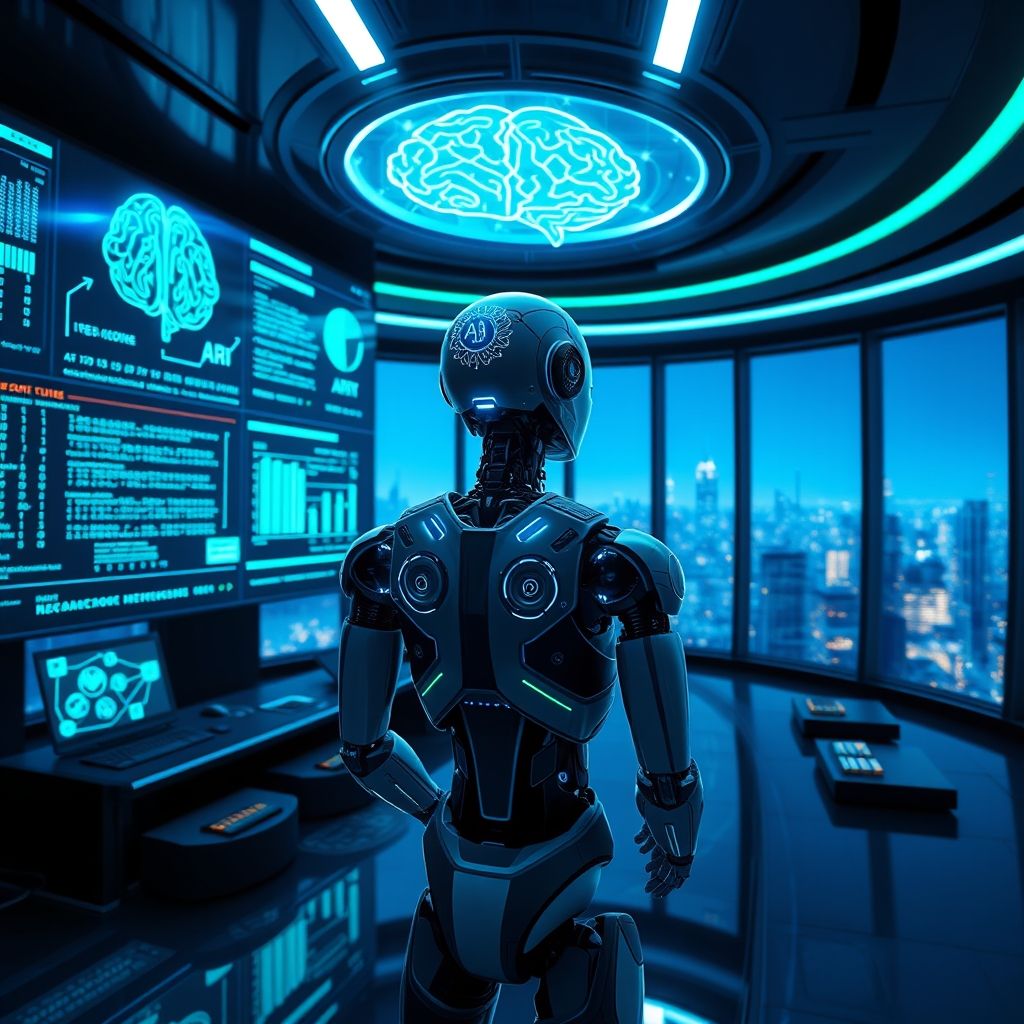Introduction: The Digital Battlefield of the 21st Century
Imagine waking up one morning to find your bank account drained, your personal photos leaked online, and your company’s customer data being auctioned on the dark web. It sounds like a scene from a cyber-thriller — but for millions of people and businesses, it’s a real, terrifying possibility. In today’s hyper-connected world, cyberattacks are no longer a matter of if but when. Every day, over 2,200 cyberattacks occur globally, according to a report by Cybint. That’s one every 39 seconds.
This is where artificial intelligence (AI) steps in — not as a sci-fi fantasy, but as a powerful, real-world defender in the digital arms race. From detecting malware before it strikes to identifying suspicious behavior in real time, AI is transforming the way we protect our data, networks, and identities. But what exactly makes AI so effective in cybersecurity? And how can businesses and individuals harness its power without falling into new risks?
In this article, we’ll explore the revolutionary role of AI in cybersecurity. We’ll dive into how it detects threats faster than humans ever could, how it adapts to evolving attack methods, and why it’s becoming a necessity — not just a luxury — for digital safety. We’ll also look at real-world examples, practical applications, and even the ethical questions that come with handing over security decisions to machines.
Whether you’re a tech enthusiast, a small business owner, or just someone who uses a smartphone, understanding AI’s role in cybersecurity can help you stay safer online. So let’s unlock the power of AI — and discover how it’s reshaping the future of digital defense.
1. How AI Detects Threats Faster Than Humans
One of the biggest challenges in cybersecurity has always been speed. Hackers move fast — often exploiting vulnerabilities in seconds. Traditional security systems rely on predefined rules and human monitoring, which can’t keep up with the volume and complexity of modern threats.
This is where AI shines.
AI-powered systems use machine learning (ML) to analyze vast amounts of data and identify patterns that indicate malicious activity. Unlike rule-based systems, which only respond to known threats, AI learns from experience. It can spot anomalies — like a user logging in from an unusual location at 3 a.m. or a device sending massive amounts of data unexpectedly — and flag them for investigation.
For example, Google uses AI in its Gmail system to filter out over 100 million spam emails every day. Its algorithms analyze the content, sender behavior, and metadata to determine whether an email is legitimate — all in milliseconds.
Here’s how it works in practice:
- AI monitors network traffic in real time.
- It builds a “baseline” of normal behavior for users and devices.
- When something deviates from that baseline, it triggers an alert.
- Security teams can then investigate or let the system automatically respond.
This kind of behavioral analysis is far more effective than relying on virus signatures or blacklists. It’s like having a security guard who doesn’t just check IDs but also notices if someone is acting suspiciously — even if they’ve never been seen before.
And the results speak for themselves. According to a 2023 report by IBM, organizations using AI in their security operations reduced breach detection time by up to 74 days compared to those relying on traditional methods.
In short, AI doesn’t just react to threats — it anticipates them.
2. AI vs. Zero-Day Attacks: Staying Ahead of the Unknown
One of the most dangerous types of cyberattacks is the zero-day attack — a threat that exploits a vulnerability no one knew existed. Because there’s no prior knowledge of the flaw, traditional antivirus software can’t detect it. These attacks are like invisible knives in the dark.
But AI is changing the game.
Instead of relying on known signatures, AI uses predictive analytics to identify potential threats based on behavior. For instance, if a piece of software starts making unusual system calls or trying to access restricted files, AI can flag it as suspicious — even if it’s never seen that specific malware before.
Take the case of Darktrace, a cybersecurity company that uses AI to protect organizations worldwide. In one instance, their AI system detected a zero-day ransomware attack on a hospital network. The malware had encrypted a few files and was preparing to spread — but Darktrace’s AI noticed the abnormal data encryption pattern and isolated the affected device before the attack could escalate.
This ability to detect the unknown is a game-changer.
AI doesn’t need a database of every possible threat. Instead, it learns what “normal” looks like and reacts when something feels “off.” It’s similar to how your body’s immune system works — it doesn’t need to know every virus by name to fight off an infection.
Key benefits of AI against zero-day threats:
- Proactive defense: Identifies threats before they cause damage.
- Adaptive learning: Improves over time as it sees more data.
- Reduced reliance on updates: Doesn’t wait for patches or definitions.
Of course, AI isn’t perfect. It can sometimes generate false positives — flagging legitimate activity as suspicious. But with continuous learning and human oversight, these errors decrease over time.
The bottom line? In a world where new threats emerge daily, AI gives us a fighting chance to stay one step ahead.
3. Automating Response: From Detection to Action
Detecting a cyber threat is only half the battle. The real challenge lies in responding quickly and effectively. In high-pressure situations, even experienced security teams can make mistakes or delay action.
AI doesn’t hesitate.
Modern AI systems don’t just raise alarms — they can automate responses to contain threats in real time. This is known as automated incident response, and it’s transforming how organizations handle cyberattacks.
Imagine this scenario: A hacker gains access to a company’s network and starts moving laterally, trying to reach sensitive databases. Within seconds, the AI system detects unusual login attempts, blocks the suspicious IP address, isolates the affected device from the network, and notifies the security team — all without human intervention.
This kind of autonomous response drastically reduces the “dwell time” — the period between when a breach occurs and when it’s contained. According to Ponemon Institute, the average dwell time in 2023 was 287 days. With AI, that number can drop to minutes or even seconds.
Examples of automated AI responses:
- Quarantining infected devices
- Resetting compromised passwords
- Blocking malicious IP addresses
- Shutting down suspicious processes
One powerful tool in this space is Security Orchestration, Automation, and Response (SOAR) platforms. These integrate AI with existing security systems to streamline threat detection, investigation, and response.
For small businesses, this is especially valuable. Many lack dedicated cybersecurity teams, making them easy targets. AI-powered tools like Microsoft Defender for Office 365 or CrowdStrike Falcon offer enterprise-level protection at a fraction of the cost.
But here’s the key: automation doesn’t replace humans — it empowers them. Security analysts can focus on complex threats and strategic decisions, while AI handles the repetitive, time-sensitive tasks.
In short, AI turns cybersecurity from a reactive game of whack-a-mole into a proactive, intelligent defense system.
4. AI in Phishing and Social Engineering Defense
Phishing attacks — where hackers trick users into revealing passwords or downloading malware — remain one of the most common and effective cyber threats. In fact, over 90% of cyberattacks start with a phishing email, according to CSO Online.
What makes phishing so dangerous is that it bypasses technical defenses by targeting human psychology. A well-crafted email that looks like it’s from your bank or boss can fool even tech-savvy users.
But AI is getting better at spotting the subtle signs of deception.
Advanced AI systems use natural language processing (NLP) to analyze the content of emails and detect phishing attempts. They look for red flags like:
- Urgent or threatening language (“Your account will be closed!”)
- Slight misspellings in sender addresses (e.g., “support@paypa1.com ”)
- Suspicious links or mismatched URLs
- Unusual request patterns (e.g., asking for login details)
For example, Google’s AI models can detect phishing emails with over 99.9% accuracy, thanks to deep learning algorithms trained on billions of emails.
But AI doesn’t stop at email. It’s also being used to combat voice phishing (vishing) and smishing (SMS phishing). Some AI tools can analyze voice patterns to detect fake customer service calls or flag suspicious text messages in real time.
Practical tips for users:
- Enable AI-powered email filters (like Gmail’s Smart Compose and spam detection).
- Use AI security apps that scan links before you click.
- Be cautious of urgent requests — even if they seem to come from someone you trust.
The beauty of AI in phishing defense is that it learns from every attack. Each time a new phishing technique emerges, the system updates its knowledge — making it harder for scammers to succeed next time.
In a world where social engineering is evolving faster than ever, AI acts as a digital lie detector — helping us separate truth from deception.
5. The Role of AI in Endpoint Protection
Every device connected to a network — laptops, smartphones, IoT gadgets — is a potential entry point for attackers. These are called endpoints, and protecting them is crucial.
Traditional antivirus software scans files for known malware. But modern threats often use fileless attacks or polymorphic malware that changes its code to avoid detection. This is where AI-driven endpoint protection comes in.
AI doesn’t just look at files — it monitors behavior. If a process starts encrypting files rapidly (like ransomware), accessing system memory unusually, or communicating with a known malicious server, the AI flags it immediately.
Key features of AI-powered endpoint protection:
- Real-time monitoring of system activity
- Behavioral analysis instead of signature-based detection
- Automatic threat isolation and remediation
- Continuous learning from global threat data
Companies like SentinelOne, Cylance, and Trend Micro use AI to provide next-generation endpoint security. These systems don’t just block threats — they can predict and prevent them.
For example, Cylance’s AI model uses mathematical algorithms to predict whether a file is malicious before it even runs. This “pre-execution” analysis stops threats in their tracks.
And it’s not just for big corporations. Many AI-powered endpoint tools are now available for home users, offering protection for personal devices without slowing them down.
Why this matters for you: Even if you’re not a business, your smartphone or laptop contains sensitive data — photos, messages, banking apps. AI endpoint protection acts like an invisible shield, working silently in the background to keep you safe.
As the number of connected devices grows — from smart fridges to wearable health trackers — AI will become essential for securing this expanding digital frontier.
6. AI and the Future of Identity Protection
Your digital identity — your usernames, passwords, biometrics, and online behavior — is one of your most valuable assets. Hackers don’t just want your money; they want you.
AI is playing a growing role in identity and access management (IAM), ensuring that only the right people can access the right systems at the right time.
One of the most exciting applications is behavioral biometrics. Instead of just checking your password, AI analyzes how you type, swipe, or move your mouse. Each person has a unique digital “fingerprint” in their behavior.
For example:
- The speed and rhythm of your typing
- The pressure you apply on a touchscreen
- The way you hold your phone
If someone logs in with your credentials but types too slowly or swipes differently, AI can flag it as suspicious — even if the password is correct.
Banks like HSBC and Barclays already use behavioral biometrics to protect customer accounts. It’s a layer of security that’s hard to fake and invisible to the user.
Other AI-powered identity tools:
- Adaptive authentication: Adjusts security requirements based on risk (e.g., asking for two-factor authentication only when logging in from a new device).
- Deepfake detection: AI can spot fake videos or voice clones used in identity fraud.
- Passwordless login: AI verifies identity through multiple signals (device, location, behavior) so you don’t need a password at all.
As identity theft becomes more sophisticated, AI offers a smarter, more seamless way to protect who we are online.
7. The Ethical Challenges: Can We Trust AI with Our Security?
While AI brings incredible benefits, it also raises important ethical and privacy concerns.
Who is responsible when an AI system makes a mistake? What happens if it blocks a legitimate user or misses a real threat? And how much personal data should AI be allowed to collect to keep us safe?
These questions are more than theoretical.
There’s also the risk of AI being used by attackers. Cybercriminals are already using AI to:
- Generate realistic phishing emails
- Bypass voice recognition systems
- Launch more targeted and convincing attacks
This creates a cybersecurity arms race — defenders use AI to protect, attackers use AI to exploit.
Moreover, AI systems can inherit biases from their training data. If an AI is trained mostly on attacks from certain regions, it might unfairly flag users from those areas as high-risk.
So, how do we build trustworthy AI?
- Transparency: Users should know how AI makes decisions.
- Human oversight: AI should assist, not replace, human judgment.
- Strong regulations: Governments and organizations must set clear rules for AI use in security.
The goal isn’t to stop AI — it’s to guide its development responsibly.
As we hand over more control to machines, we must ensure they protect all of us — not just the privileged few.
Conclusion: Embracing AI as a Partner in Cybersecurity
The digital world is both a wonder and a battlefield. Every click, login, and message carries risk. But thanks to artificial intelligence, we’re no longer fighting with outdated weapons.
From detecting zero-day threats to stopping phishing scams and protecting our identities, AI is revolutionizing cybersecurity. It’s faster, smarter, and more adaptive than any human or traditional system could be. And while it’s not perfect, its potential to save time, money, and lives is undeniable.
But remember: AI is a tool — not a magic solution. It works best when combined with human intelligence, good policies, and user awareness. The strongest defense isn’t just technology; it’s a culture of security.
So what can you do today?
- Enable AI-powered security features on your devices and accounts.
- Stay informed about new threats and how AI is helping to stop them.
- Think before you click — no AI can replace your own vigilance.
The future of cybersecurity isn’t about humans versus machines. It’s about humans and machines working together to build a safer digital world.
What’s your experience with AI in security? Have you ever been protected by an AI system without even knowing it? Share your thoughts in the comments — let’s keep the conversation going.
Because in the fight against cybercrime, everyone has a role to play.

Danilo Ferreira is a passionate entrepreneur, travel, and financial freedom enthusiast, always seeking new ways to expand his horizons and live with purpose. Driven by a high-performance mindset, he combines discipline and curiosity to achieve ambitious goals, exploring the world while building projects that reflect his vision of independence and continuous growth.







